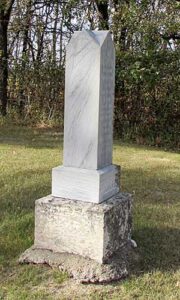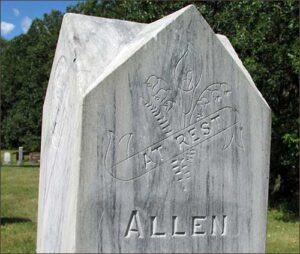June 2015
QR Cemetery Tour. CDMHAC has just received confirmation of a heritage grant to prepare a brochure and guide on cemeteries in the Town and R M of Dufferin. Using QR code technology, viewers will be able to access an online guide that outlines special features of the cemetery including styles of tombstones, materials used and meaning of symbolism on the grave markers. You’ll be hearing more about this project in the coming months.
Cemetery project. In every successful project, you learn something new. Hopefully, not just a bunch of facts, but information that changes how you look at some small part of the world. From that perspective, our latest project should be a winner.
C/DMHAC received a heritage grant this summer to develop a brochure with a map of Carman/Dufferin cemeteries. A QR code on the brochure will take viewers with smartphones to an online guide that highlights features to look for in each of our nine local cemeteries, including changing styles and materials, interesting inscriptions, the meaning of designs found on the markers and so forth. Data collection is well under way with the hope of completing much of the first phase of the project before snowfall.
For a sneak preview of what we’re finding, here’s the first grave marker we looked at.

Marble column in Roseisle Cemetery

Close-up of details
Most of us would recognize the materials in this marker. It’s made of marble, resting on a limestone base and stabilized on a cement foundation which was possibly exposed by many years of soil erosion. From the materials and column style you’ll likely guess it’s from the early 1900s. And you might admire the pretty design, but would you recognize the symbolism of the flowers—the calla lily (beauty, marriage) and the lily-of-the-valley (an early Spring flower representing renewal and resurrection)?
It turned out there’s a lot more to learn about this marker. This is where the expertise of our resource person, Murray Billing, comes in. Recently retired from family-owned Carman Granite, Murray is lending his special knowledge to the project by identifying different techniques, processes and materials used in creating the markers. He explained, for example, that those sharp, v-shaped letters were done by hand with a chisel. We’ll explain this process and others later in our guide. And did you notice where the name has been corrected? I didn’t. But it was obvious after Murray pointed out the faint markings at each end of the name, combined with a slight cupping that could be felt where the soft marble surface had been ground down. There was more to be learned but we’ll leave a few insights for the finished project.
That was just the first gravestone, and we’ve already learned a few things and become more observant. Hope you’ll look for our guide and more information next summer when the project is completed.
August 2016
NEW ON OUR WEBSITE. Our Guide to Carman-Dufferin Cemeteries is now online.
Tour the nine public cemeteries and learn more about their location, history and layout, changing styles and materials of gravestones, symbolic meaning of designs, and changing craftsmanship. You will also find a section on location and background information on abandoned burial sites.The cemetery project began last fall with visits to each of our public cemeteries and initial photos of most of the grave markers. In larger cemeteries such as Carman Greenwood, we photographed samples or small sections of the cemetery, looking for examples of different styles, materials and craftsmanship, interesting inscriptions, symbols and motifs.
It was a fascinating project, partly because we learned how much more there is to see when you know what to look for, even in places you have visited all your life. Winter storms and soggy spring days were welcomed as an excuse for escaping into research and writing.
The final products are: 1) a guide to the nine public cemeteries in the municipalities, plus a section on abandoned burial sites; 2) a brochure with map of cemetery locations and QR code to access online version of the guide, and 3) signs which will be placed in cemeteries, giving QR code access to online guide content specific to the cemetery. The guide can be accessed online now; brochures and signs will available this fall.
